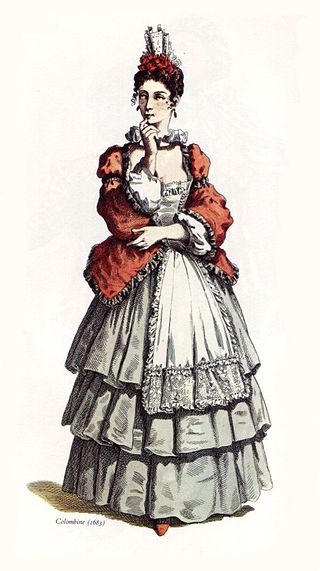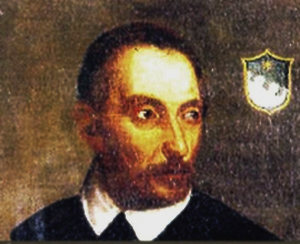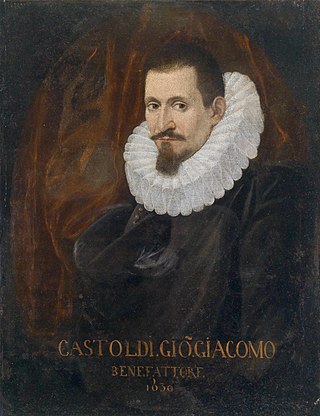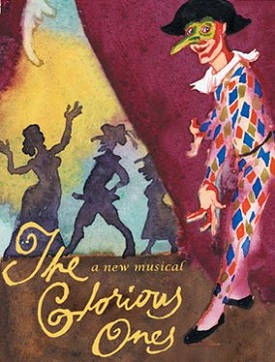This article includes a list of general references, but it lacks sufficient corresponding inline citations .(January 2017) |

L'Amfiparnaso is a madrigal comedy [1] by composer Orazio Vecchi. It was published in Venice in 1597.
This article includes a list of general references, but it lacks sufficient corresponding inline citations .(January 2017) |

L'Amfiparnaso is a madrigal comedy [1] by composer Orazio Vecchi. It was published in Venice in 1597.
Madrigal comedy, or Commedia harmonica (as known in the 16th century Italian vernacular) was a genre that flourished briefly from 1590 for about twenty years, previous to the first operas. Some of them were collections of pieces, while others used commedia dell'arte characters and told a full story through the medium of three or five-voice ensemble. The two principal composers were Adriano Banchieri and Orazio Vecchi, both contemporaries of Claudio Monteverdi.
Although in the dedication Vecchi describes the dedicatee, Alessandro D'Este, as having heard a performance of L'Amfiparnaso, the date of the premiere is unknown. In 1844 historian François-Joseph Fétis proposed a date of 1594 for the work's premiere, but this was based on incorrect assumptions about the early history of opera and Vecchi's place in it. [2]
Pantalone - central figure of Commedia dell'arte Doctor Gratiano - the old man Captain Cardon Lovers - Isabella, Lucio, Lelio, Nisa The Zanni - Pedrolino, Zanni, Francatrippa, Frulla
Act 1
Scene 1. Pantalone is smitten by the charms of the courtesan Hortensia, but the ungrateful woman is not interested in the old man's affections.
Scene 2. Lelio is doubtful about the feelings of his beloved Nisa, and concludes from her present of a flower that there is little love in her for him.
Scene 3. Pantalone promises his daughter Isabella to doctor Gratiano, because he likes the clumsy fellow, who answers badly and listens even worse.
Act 2
Scene 1. Because he believes that his beloved Isabella is in love with Captain Cardone, in utter jealousy Lucio announces he will jump into the abyss.
Scene 2. Cardone quarrels with Zane, because after many hints he won't understand him, but he rather confuses him so that his answers are strange. Nevertheless, eventually he knocks on Isabella's door.
Scene 3. Isabella pretends to be in love with the Spanish Captain, so that when she dies she would more hurt his insatiable desires.
Scene 4. As soon as the Captain is gone Isabella bursts out lamenting for Lucio. She courageously draws a dagger to depart from life.
Scene 5. Frulla persuades Isabella not to thrust the dagger by telling her that her lover Lucio is still alive.
Act 3
Scene 1. As the wedding contract between Pantalone and Gratiano has been agreed upon, they joyfully start planning festivities.
Scene 2. With a melting and enamoured voice the Doctor sings a gracious madrigal under the balcony of his lovely bride.
Scene 3. Francatrippa goes to the Jews to pawn a hangmat. He knocks at the door and a noise is heard of many voices in different languages.
Scene 4. From a distance the faithful lovers meet rejoicing in their presence, pledging to be true till death.
Scene 5. Everybody is now content and happy. Isabella and Lucio are wed and a great exchange of valuable gifts is displayed.
Many recordings of L'Amfiparnaso exist with a variety of performance style choices. A 2003 DVD recording by I Fagiolini, directed by Robert Hollingworth, chooses to forgo any text or scene, but does however introduce each piece with an English introduction narrated by Simon Callow. Numerous recordings exist using multiple numbers of singers and drastically different choices of accompaniment.

Francesco Andreini was an Italian actor mainly of commedia dell'arte plays. He began his career playing the role of the unsophisticated love-stricken young man. Later he played the role of Capitan Spavento, a Pickwickian character of excessive fatigue. He died on January 1, 1624, in Mantua, Italy at the age of 76.

Columbina is a stock character in the commedia dell'arte. She is Harlequin's mistress, a comic servant playing the tricky slave type, and wife of Pierrot. Rudlin and Crick use the Italian spelling Colombina in Commedia dell'arte: A Handbook for Troupes.

Gli Innamorati were stock characters within the theatre style known as commedia dell'arte, who appeared in 16th century Italy. In the plays, everything revolved around the Lovers in some regard. These dramatic and posh characters were present within commedia plays for the sole purpose of being in love with one another, and moreover, with themselves. These characters move elegantly and smoothly, and their young faces are unmasked unlike other commedia dell'arte characters. Despite facing many obstacles, the Lovers were always united by the end.

Pantalone[pantaˈloːne], spelled Pantaloon in English, is one of the most important principal characters found in commedia dell'arte. With his exceptional greed and status at the top of the social order, Pantalone is "money" in the commedia world. His full name, including family name, is Pantalon de' Bisognosi, Italian for "Pantalone of the Needy".

Il Capitano is one of the four stock characters of Commedia dell'arte. He most likely was never a "Captain" but rather appropriated the name for himself.

Adriano Banchieri was an Italian composer, music theorist, organist and poet of the late Renaissance and early Baroque eras. He founded the Accademia dei Floridi in Bologna.

Harlequinade is a English comic theatrical genre, defined by the Oxford English Dictionary as "that part of a pantomime in which the harlequin and clown play the principal parts". It developed in England between the 17th and mid-19th centuries. It was originally a slapstick adaptation or variant of the Commedia dell'arte, which originated in Italy and reached its apogee there in the 16th and 17th centuries. The story of the Harlequinade revolves around a comic incident in the lives of its five main characters: Harlequin, who loves Columbine; Columbine's greedy and foolish father Pantaloon, who tries to separate the lovers in league with the mischievous Clown; and the servant, Pierrot, usually involving chaotic chase scenes with a bumbling policeman.
Il Dottore, commonly known in Italian as Dottor Balan or simply Balanzone is a commedia dell'arte stock character, in one scenario being an obstacle to young lovers. Il Dottore and Pantalone are the comic foil of each other, Pantalone being the decadent wealthy merchant, and Il Dottore being the decadent erudite. He has been part of the main canon of characters since the mid-16th century.

Orazio Vecchi was an Italian composer of the late Renaissance. He is most famous for his madrigal comedies, particularly L'Amfiparnaso.

Madrigal comedy is a term for a kind of entertainment music of the late 16th century in Italy, in which groups of related, generally a cappella madrigals were sung consecutively, generally telling a story, and sometimes having a loose dramatic plot. It is an important element in the origins of opera. The term is of 20th-century origin, popularised by Alfred Einstein.

Giovanni Giacomo Gastoldi was an Italian composer of the late Renaissance and early Baroque periods. He is known for his 1591 publication of balletti for five voices.

Pedrolino is a primo zanni, or comic servant, of the Commedia dell'Arte; the name is a hypocorism of Pedro (Peter), via the suffix -lino. The character made its first appearance in the last quarter of the 16th century, apparently as the invention of the actor with whom the role was to be long identified, Giovanni Pellesini. Contemporary illustrations suggest that his white blouse and trousers constituted "a variant of the typical zanni suit", and his Bergamasque dialect marked him as a member of the "low" rustic class. But if his costume and social station were without distinction, his dramatic role was certainly not: as a multifaceted "first" zanni, his character was—and still is—rich in comic incongruities.
Le Médecin volant is a French play by Molière, The date of its actual premiere is unknown, but its Paris premiere took place on 18 April 1659. Parts of the play were later reproduced in L'Amour médecin, and Le Médecin malgré lui. It is composed of 15 scenes and has seven characters largely based on stock commedia dell'arte roles.
Girolamo Conversi was an Italian composer of the late Renaissance. His music, which was popular from the 1570s through the 1590s, was noted for its combination of the light canzone alla napolitana with the literary and musical sophistication of the madrigal. He appears to have written only secular vocal music.

The Glorious Ones is a musical with book and lyrics by Lynn Ahrens and music by Stephen Flaherty. Set in 17th-century Italy, it concerns a theatre group in the world of commedia dell'arte and theatre of the Italian Renaissance.

Commedia dell'arte was an early form of professional theatre, originating from Italian theatre, that was popular throughout Europe between the 16th and 18th centuries. It was formerly called Italian comedy in English and is also known as commedia alla maschera, commedia improvviso, and commedia dell'arte all'improvviso. Characterized by masked "types", commedia was responsible for the rise of actresses such as Isabella Andreini and improvised performances based on sketches or scenarios. A commedia, such as The Tooth Puller, is both scripted and improvised. Characters' entrances and exits are scripted. A special characteristic of commedia is the lazzo, a joke or "something foolish or witty", usually well known to the performers and to some extent a scripted routine. Another characteristic of commedia is pantomime, which is mostly used by the character Arlecchino, now better known as Harlequin.

The Unicorn, the Gorgon and the Manticore or The Three Sundays of a Poet is a "madrigal fable" for chorus, ten dancers and nine instruments with music and original libretto by Gian Carlo Menotti. Based on the 16th-century Italian madrigal comedy genre, it consists of a prologue and 12 madrigals which tell a continuous story, interspersed with six instrumental interludes. The unicorn, gorgon, and manticore in the title are allegories for three stages in the life of the story's protagonist, a strange poet who keeps the mythical creatures as pets. The work premiered in Washington D.C. at the Library of Congress Coolidge Auditorium on October 19, 1956.
Flaminio Scala, commonly known by his stage name, Flavio, was an Italian stage actor of Commedia dell'Arte, scenario writer, playwright, director, producer, manager, agent, and editor. Considered one of the most important figures in Renaissance theatre, Scala is remembered today as the author of the first published collection of commedia scenarios, Il Teatro delle Favole Rappresentative, short comic plays that served as inspiration to playwrights such as Lope de Vega, William Shakespeare, Ben Jonson, and Molière.

La capricciosa corretta is a comic opera in two acts composed by Vicente Martín y Soler. The libretto is by Lorenzo Da Ponte and has a plot which has a slight similarity to William Shakespeare's play The Taming of the Shrew, but is not based on it. The story takes place over a 24-hour period and examines the marriage of an older man to his vain and capricious second wife whose antics make her husband, stepchildren, and servants miserable until she is finally brought to heel through the machinations of her husband's major domo. The opera premiered under the title La scuola dei maritati at the King's Theatre in London on 27 January 1795 to considerable success. It was later performed throughout Europe under the alternative titles Gli sposi in contrasto, La moglie corretta, and La capricciosa corretta—the title used by Da Ponte and the one by which it is known today.

Lélio is a stock character of the commedia dell'arte.